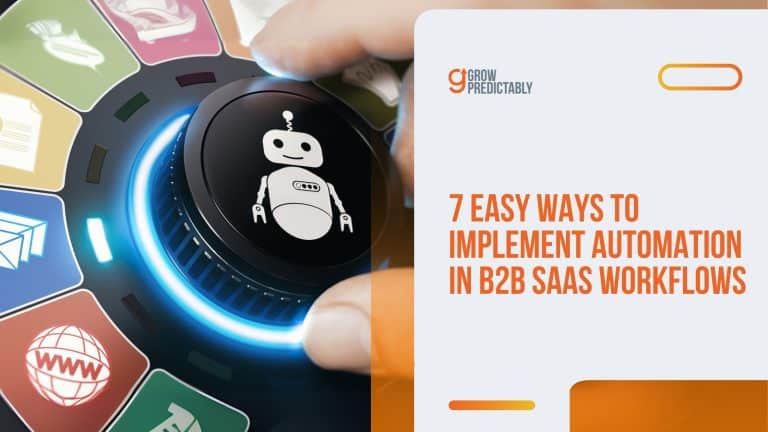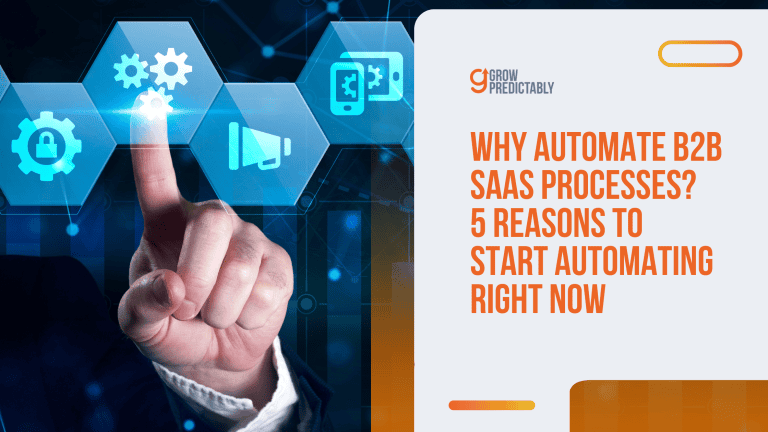How Can AI Improve B2B Operational Efficiency? 5 Case Studies
Boosting B2B efficiency isn’t about hiring faster or buying shiny tools.
It’s about fixing how work actually gets done.
And AI quietly rewrites that playbook.
Ignore it, and high costs, slow service, and burnout keep stacking up.
But use it right, and your operations run smoother—even under pressure.
Want the behind-the-scenes tactics on how can AI improve B2B operational efficiency?
Let’s take a look at five real-world examples from different case studies plus what you can take away from these examples.
Defining AI’s Role in Enhancing B2B Operational Efficiency
Picture this: Your team saves 360,000 work hours with AI tools.
That’s not science fiction – it’s what happened at JPMorgan. (Source)
Now imagine what similar efficiency gains could do for your business.
Let’s talk about the role of AI in B2B operational efficiency – it’s about working smarter, not harder.
When companies struggle with slow invoice processing, missed sales forecasts, and growing service backlogs, they’re leaving money on the table.
But here’s where AI steps in as your silent efficiency partner.
Think of AI as your 24/7 project manager who never gets tired and keeps getting better at their job.
Here’s what makes up this digital powerhouse:
📌 Machine Learning (ML)
Like a seasoned manager who learns from past experiences, ML studies patterns in your customer data and more to make smart predictions and automate decisions.
For example, it can spot when a client might need a reorder before they even know it.
📌 Robotic Process Automation (RPA)
Remember those repetitive tasks eating up your team’s day?
RPA handles them lightning-fast.
It’s like having a super-efficient assistant processing purchase orders and entering data without breaks or errors.
📌 Natural Language Processing (NLP)
This is your email-reading, contract-reviewing champion.
NLP understands written language, helping sort urgent messages from routine ones and flagging important contract terms.
📌 Predictive Analytics
Want to know what’s coming before it hits? That’s what predictive analytics does with your historical data.
Using your historical data predictive analytics can forecast trends and help you stay ahead of demand curves.
I know what you might be thinking: “Will AI replace my team?”
Here’s the truth – AI isn’t about replacing humans; it’s about empowering them.
While AI handles the number-crunching and repetitive work, your team can focus on what humans do best: building relationships, crafting strategy, and making complex decisions.
The real magic in operational efficiency happens when AI and human expertise work together.
Companies like JPMorgan, Meta, and Hilton discovered this.
They turned their biggest operational headaches into breakthrough moments by implementing AI driven solutions.
When you boil it down, AI in B2B brings three game-changing benefits to operations:
- Smarter decisions backed by real-time data
- Faster processes that scale with your growth
- Consistent quality that builds client trust
Ready to see how industry leaders are using AI to transform their operations?
Keep reading – their stories might just spark your next big breakthrough.
Technical Terms
- Machine Learning: Computer systems that improve through experience
- RPA: Software robots that perform repetitive tasks
- NLP: Technology that processes human language
- Predictive Analytics: Data analysis that forecasts future trends
5 Core Benefits of AI for B2B Operational Efficiency
Wouldn’t you want your team to embrace AI in B2B and spend more time building client relationships instead of drowning in spreadsheets?
For the market-leading B2B companies, this is the ultimate objective.
Let’s break down the game-changing benefits that make AI tools worth your attention.
1. Cost Reduction through Automation
When repetitive tasks eat up your day, costs spiral.
Smart automation flips this story:
- Cuts processing time for routine tasks by up to 80%
- Reduces human error rates in data entry from 4% to 0.4%
- Saves money on overtime and temporary staffing
Real numbers tell the story.
JPMorgan’s AI system now handles document reviews in seconds, saving over 360,000 work hours yearly.
Think about reinvesting that time in growth.
2. Increased Accuracy and Consistency
Mistakes hurt both bottom lines and relationships.
AI brings reliability:
- Catches 99% of invoice errors before they reach clients
- Maintains perfect data consistency across platforms
- Reduces dispute resolution time by 35%
3. Scalable Growth Without Headcount Explosion
Growing pains?
AI helps you expand without proportional staff increases:
- Handle 5x more client accounts with your current team
- Process unlimited data points without hiring data analysts
- Maintain service quality during peak periods
4. Faster, Better Decision Making
Stop guessing, start knowing.
AI turns data into action:
- Real-time dashboard insights, which analyze customer data, guide resource allocation
- Predictive analytics spot trends before they impact operations
- Risk assessment happens in minutes, not days
5. Better Customer Experience
Happy clients stay longer and spend more, boosting customer satisfaction
- For enhanced operational efficiency, smart systems respond to support tickets 24/7
- Personalized communications crafted based on customer behavior improve customer engagement
- Client satisfaction scores jump by 23% on average
Let’s put numbers to these benefits in the context of enhanced business operations:
| Benefit Area | Before AI | After AI |
|---|---|---|
| Invoice Processing Time | 4 hours | 15 minutes |
| Error Rate | 4% | 0.4% |
| Client Load per Team | 20 accounts | 100 accounts |
| Response Time | 24 hours | 10 minutes |
| Data Analysis Speed | 3 days | 30 minutes |
Remember: These aren’t just statistics – they’re opportunities waiting for you to grab them.
Want to see exactly how these play out in real business scenarios?
Later, we’ll dive into real-world examples showing these benefits in action.
You’ll discover how industry leaders transformed their operations – and how you can too.
Practical AI Applications Transforming B2B Operations
Are you ready to see AI in action improving operational efficiency?
Let’s explore five game-changing ways companies are using AI to work smarter, not harder.
Supply Chain Magic: Cutting Through Bottlenecks
Picture this: your supply chain management running like clockwork, informed by customer behavior insights.
That’s what happened when companies started using smart tools to better understand customer behavior:
- Coupa’s spend tracking system spots buying patterns and flags cost-saving chances.
- IBM’s Watson watches supply routes in real-time, saving $160M during COVID-19.
- Smart sensors keep constant watch on inventory management, sending instant updates.
Smart CRM: Your Digital Sales Partner
Sales teams are falling in love with CRM systems that think ahead:
- Salesforce Einstein reads customer behavior signals and picks the perfect time to reach out.
- Marketing teams now handle more accounts without burning out.
- Smart scheduling frees up time for building real relationships.
Price Setting That Makes Sense
Gone are the guessing games with pricing:
- PROS Smart Price system watches market changes and adjusts prices automatically.
- Real results? Retailers grabbed 12% more revenue.
- Unsold products dropped by 40% – that’s money back in your pocket.
Equipment Care That Sees The Future
Nobody likes surprise breakdowns.
Here’s the fix:
- Shell caught equipment problems early on their offshore rigs.
- Downtime dropped by 30% – keeping operations smooth.
- Manufacturing teams now fix issues before they become problems.
People-First Scheduling
Happy teams = better work.
Check this out:
- Hilton lets AI match staff schedules with busy periods.
- DHL keeps their team happy with smart scheduling.
- Result? Less burnout, more smiles, better service.
Remember: AI isn’t replacing anyone – it’s giving your team superpowers.
Think of it as your behind-the-scenes helper, making sure everything runs smoothly while your people focus on what matters most: building relationships and solving problems.
5 Case Studies on AI Unlocking B2B Operational Efficiency (With Takeaways)
A financial giant eliminates 360,000 hours of tedious work. A tech company boosts income by 201%.
These aren’t just stories – they’re real victories from companies using AI to master efficiency.
Companies are constantly searching for innovative ways to increase efficiency, reduce costs, and optimize performance.
Now, let’s take a closer look at four companies that achieved this feat with the power of AI.
1. Demandbase’s AI-Driven Pipeline Boost

Demandbase, a leading marketing technology company, implemented AI solutions to revolutionize their sales and marketing processes.
Problem
Before adopting AI, Demandbase struggled with a fragmented website engagement strategy and inefficient inbound sales processes.
They faced challenges in generating high-quality leads from their website due to a lack of integration with their CRM and marketing systems, leading to missed opportunities and inefficiencies.
Method
To tackle these issues, Demandbase implemented Qualified’s AI-driven solution, Piper the AI Sales Development Representative (SDR).
Piper was deployed to engage website visitors and streamline the lead qualification process through real-time interactions.
Additionally, AI tools like AI Meetings and AI Offers were utilized to enhance meeting scheduling and content delivery.
Results
- 2X Increase in pipeline within the first two months.
- 37% Increase in meetings booked from target accounts.
- 431% Increase in visitor engagement, leading to more conversations.
- $80K Annual Savings by offsetting the cost of additional SDRs.
Takeaway
Demandbase’s success with AI highlights the importance of integrating AI solutions strategically to target areas with the highest impact, such as lead qualification and visitor engagement.
Businesses aiming to replicate Demandbase’s results should focus on utilizing AI to automate repetitive engagement processes and provide real-time customer interactions.
2. Gong’s Data-Driven Sales Transformation at Demandbase

By leveraging Gong’s conversational analytics platform, Demandbase optimized its sales strategies and performance.
Problem
Demandbase faced challenges in uncovering market opportunities and coaching sales teams effectively, resulting in inconsistent sales performance and missed opportunities.
Method
Gong’s solution provided Demandbase with comprehensive insights into sales conversations, enabling them to identify best practices and coaching opportunities.
The platform’s competitive intelligence and collaboration features further facilitated cross-team alignment and operational improvements.
Results
- 25% Increase in annual contract value in certain segments.
- 15% Reduction in onboarding time.
- 11% Boost in competitive win rates.
- 5% Overall Increase in win rates.
Takeaway
Gong’s impact underscores the power of AI-driven analytics in sales optimization.
To emulate these results, businesses should focus on collecting and analyzing conversational data to identify winning strategies and enhance collaboration across teams.
3. Infosys BPM’s RPA Revolution in HR Processes

Infosys BPM utilized Robotic Process Automation (RPA) to enhance HR operations for a global consultancy client.
Problem
Faced with a high volume of transactions and complex processes, the client’s HR operations needed a solution to manage workflows efficiently without sacrificing compliance and quality.
Method
Infosys BPM meticulously identified processes suitable for RPA, automating tasks such as data synchronization, validation, and report generation.
By embedding business rules in bots, repetitive manual tasks were minimized, speeding up processes and eliminating errors.
Results
- 65% Reduction in manual efforts in shift allowance calculation.
- 85% Decrease in manual effort for background verification.
- 90% Faster offer letter generation.
- 70% Overall Manual Effort Reduction across processes.
Takeaway
Infosys BPM’s use of RPA showcases how AI can significantly improve operational efficiency in HR.
Organizations looking to replicate these results need to conduct thorough process assessments to identify tasks that can be effectively automated.
4. Eastridge’s Seamless Sales and Marketing Alignment with Ops Hub

Eastridge, a professional services provider, aligned their sales and marketing operations using HubSpot’s Operations Hub.
Problem
Eastridge struggled with operational misalignment between their sales and marketing systems, resulting in data discrepancies and inefficient campaign management.
Method
By implementing Operations Hub for seamless integration between MS Dynamics and HubSpot, Eastridge automated data synchronization processes, ensuring that sales and marketing efforts were aligned and informed by accurate data.
Results
- 10% Customer Growth due to more precise marketing efforts.
- 25% Growth in employee satisfaction, attributed to reduced manual work.
- 4+ Hours Saved per week on data management.
Takeaway
Eastridge’s success demonstrates the importance of synchronizing sales and marketing platforms to improve data-driven decisions.
Companies aiming for similar success should invest in solutions that facilitate seamless data integration, enhancing both operational efficiency and team alignment.
5. Transforming Sales Pipeline with Abmatic AI

A high-growth B2B SaaS company significantly enhanced its sales pipeline and customer engagement using Abmatic AI’s personalization and real-time engagement solutions.
Problem
The company faced low conversion rates due to generic messaging, lacked sales intelligence, had inefficient targeting, and struggled with a disjointed martech stack that siloed marketing and sales data.
Method
By implementing Abmatic AI, the company unified website personalization, outbound campaigns, and sales intelligence.
They utilized AI-driven web personalization, competitor tech tracking, engagement scoring integrated with Salesforce, and multi-channel personalization strategies.
Results
- 217% Increase in Sales Pipeline from personalized inbound and outbound experiences.
- 3.5X Higher Conversion Rate on key landing pages with AI-driven personalization.
- 46% Faster Sales Cycle by leveraging engagement scoring and real-time intent data.
Takeaway
The company’s transformation underscores the power of AI in aligning marketing and sales efforts through personalized experiences and real-time data integration.
Businesses should consider adopting AI solutions that enable dynamic content delivery and seamless data integration to achieve substantial pipeline growth and efficiency.
The pattern is evident: From moving products to managing campaigns, these companies didn’t just speed things up – they changed how work gets done.
These real world examples demonstrated that AI isn’t about replacing people – it’s about empowering them.
Keep reading to learn the step-by-step playbook for making it happen.
Step-by-Step Guide to Implementing AI for Operational Efficiency

AI tools clearly hold the power to help your business generate better results, but that doesn’t mean using just about any AI tool available.
You need a system to properly implement AI.
Let’s walk through six straightforward steps that’ll help you get there, whether you’re tech-savvy or just starting out.
1. Find Your Time-Drains
Pull up your calendar and track repeated tasks.
Look for patterns in:
- Endless email chains
- Manual data entry
- Report generation
- Customer support queries
Quick tip: Time each task for a week to spot your biggest opportunities.
2. Pick Your Tools Wisely
Match your needs to proven solutions:
- Drowning in emails? → Gmail’s smart compose
- Buried in spreadsheets? → Microsoft Power Automate
- Swamped with customer queries? → Zendesk AI
Start with free trials to test what clicks.
Remember: The right AI tools will feel natural, not forced.
3. Start Small, Win Big
Pick one process – maybe lead scoring or invoice processing.
Set clear goals:
- Time saved per week
- Error reduction percentage
- Customer response speed
Run a 30-day test with a small team.
Document everything – wins and hiccups alike.
4. Bring Your Team Along
Share real wins from the pilot.
Make learning fun:
- Host lunch-and-learn sessions
- Create quick-start guides
- Celebrate small victories
Keep it simple: Focus on how AI helps, not how it works.
5. Build on What Works
Review your pilot results.
Scale successful tools team by team.
Keep asking: “What else takes too much time?”
Stay focused on measurable improvements.
6. Track Your Wins
Compare before/after metrics:
- Task completion times
- Error rates
- Team satisfaction
- Customer feedback
Share success stories.
Keep fine-tuning based on feedback.
Remember: You don’t need to transform everything overnight.
Start with one task that’s slowing you down, and build from there.
Even small improvements add up to big wins over time.
Ready to take the first step?
Next up: We’ll tackle common bumps in the road and how to smooth them out.
5 Common Obstacles to Operational AI Use
What happens when your AI rollout hits a wall of bad data or team resistance?
Don’t worry – you’re not alone.
Every business faces bumps on the road to smarter operations.
Let’s break down these challenges and tackle them head-on.
Data Silos and Quality Issues
Bad data can throw a wrench in your AI plans.
Here’s your fix:
- Connect your systems using integration tools like MuleSoft to create a single source of clean data
- Run quarterly data cleanups – mark your calendar and make it a team priority
- Start with one data stream and perfect it before expanding
Skill Gaps
Feeling overwhelmed by the technical side?
Try this approach:
- Pick one team member who’s excited about AI to champion your first project
- Look into micro-certifications – they’re bite-sized and practical
- Partner with AI consultants for the complex stuff while your team builds confidence
Cost Management
You don’t need to break the bank.
Here’s a smart spending plan for your AI adoption:
- Start small: Use AI tools to optimize one process that’s causing headaches
- Test free trials of AI tools before committing
- Track ROI from day one to justify further investment
Cultural Resistance
When your team says “We’ve always done it this way,” try this:
- Share quick wins: “Look how we just saved 3 hours on invoice processing!”
- Let team members suggest which tasks they’d love to automate
- Celebrate time saved as “freedom to focus on what matters”
Managing Expectations
Keep it real with these guardrails:
- Set clear, measurable goals (like “reduce processing time by 25%”)
- Document small wins to build momentum
- Focus on progress, not perfection
Top 3 Pitfalls to Dodge in Your First Quarter:
- Taking on too much too fast
- Skipping team training
- Not measuring baseline performance before starting
Remember: Every successful AI adoption started exactly where you are now.
You don’t need to transform everything overnight.
Pick one challenge, solve it well, and build from there.
Your journey to smoother operations starts with that first step.
FAQs
AI: Your Competitive Edge in B2B
Operational bottlenecks, human error, rising costs—every B2B leader faces them.
But as we’ve discovered, these aren’t permanent problems—they’re solvable with today’s AI technologies.
This article revealed how AI is empowering teams to do more meaningful work while machines handle the mundane.
Whether it’s using predictive analytics to prepare for future trends or RPA to slash admin burden—the path to smarter, leaner operations is clear.
Don’t wait to fall behind. Knowledge is just one click away.
What’s stopping your business from implementing AI today—and how can we help you overcome it?
In a world where agility wins, AI isn’t optional. It’s your lever to leap ahead.
Make the move now—before your competitors do.








